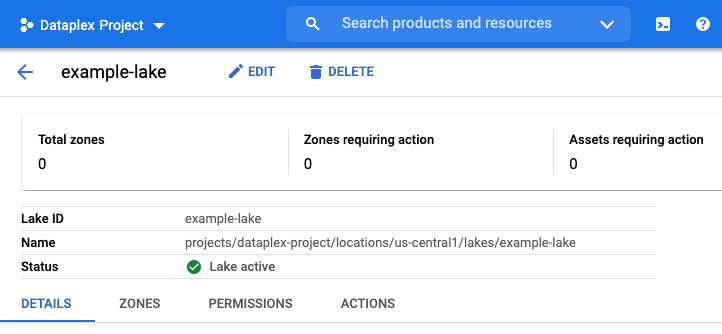This page explains how to view, update, and delete an existing Dataplex Universal Catalog lake.
Before you begin
- If you haven't done so already, create a lake.
Required roles
To update a lake, you must be granted the IAM role that contains the
dataplex.lakes.createpermission. For example, Dataplex Administrator (roles/dataplex.admin) or Dataplex Editorroles/dataplex.editorIAM role.To delete a lake, you must be granted IAM role that contains the
dataplex.lakes.deletepermission. For example, Dataplex Administrator (roles/dataplex.admin) or Dataplex Editor (roles/dataplex.editor) IAM role.
You can also grant update and delete permissions to users or groups
by using the roles/owner and roles/editor legacy roles.
For more information, see Dataplex Universal Catalog access control with IAM.
View a lake
To view your Dataplex Universal Catalog lake in the Google Cloud console, follow these steps:
Go to the Dataplex Universal Catalog Lakes page.
Click the name of the lake you want to view.

Optional: To manage existing data zones in your lake or to add new data zones, click the Zones tab. For more information, see Managing a zone.
Optional: to view lake details, such as the number of data items discovered, and the assets in the lake, click the Details tab.
Optional: To manage lake permissions, click the Permissions tab. For more information, see Access control with IAM.
Optional: To view lake-level actions, specifically, issues around security policy propagation., click the Actions tab.
View lake-level actions, specifically issues around security policy propagation. For more information, see Discover data.
Update a lake
Only one update job is supported at a time, and each job can have multiple property updates. You can still use the lake while it's being updated.
You can update the following lake parameters:
- Name
- Description
- Labels
To update a lake, follow these steps:
Console
In the Google Cloud console, go to the Dataplex Universal Catalog Lakes page.
On the Lakes page, click the lake name of the lake you want to update. The lake page for that lake opens.
Click Edit. The Edit Lake page opens.
Choose the updated lake parameter values.
Click the Save button to update the lake.
Verify that you have returned to the Lakes page, and that your updated lake appears in the list.
REST
To update a lake, use the lakes.patch method.
When the update succeeds, the lake automatically enters active state. If it fails, then the lake is rolled back to its previous healthy state.
Delete a lake
You might want to delete your lake if your configurations are wrong and can't be changed.
You can't delete a lake until all data zone resources under it have been deleted. Similarly, you can't delete a data zone until all asset resources under it have been deleted. Users given access to data through these lakes or data zones lose access rights.
Console
In the Google Cloud console, go to the Dataplex Universal Catalog Lakes page:
On the Lakes page, click the lake name of the lake you'd like to delete. The lake page for that lake opens.
Click Delete. The Delete lake dialog opens.
To confirm the deletion, enter
delete.Click Delete Lake.
Verify that you have returned to the Lakes page, and that your deleted lake no longer appears in the list.
REST
To delete a lake, use the lakes.delete method.
Deletion might take some time to complete.
What's next
- Learn how to manage a zone.
- Learn how to manage and attach buckets.
- Learn more about Cloud Audit Logs.
